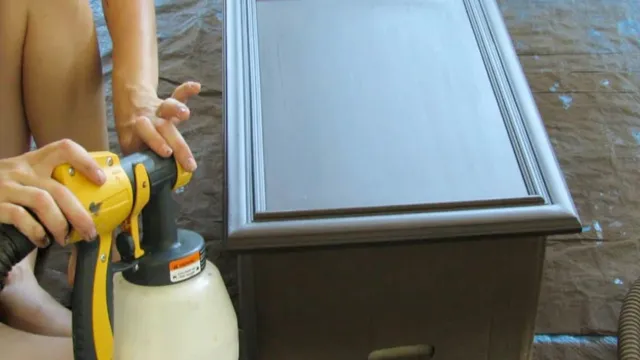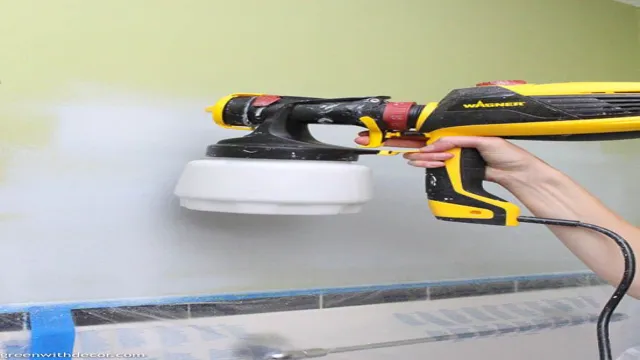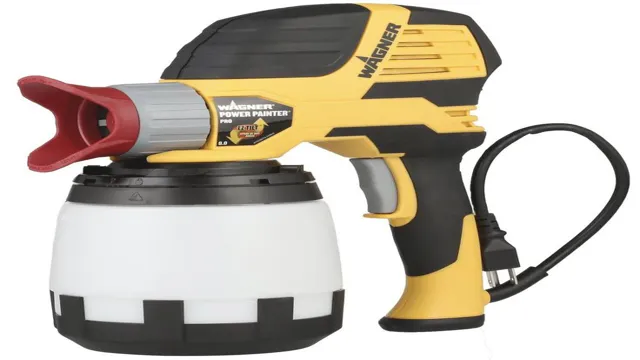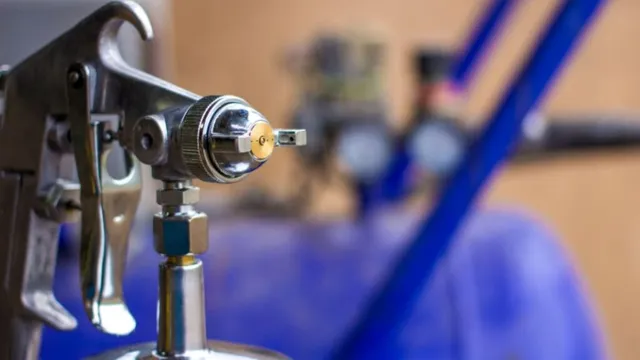Can You Use a Paint Sprayer for Polyurethane? Expert Tips and Tricks

Looking for an alternative to brush strokes and time-consuming hand applications for your polyurethane coating? Look no further than a paint sprayer! Whether you’re a DIY enthusiast or a professional contractor, a paint sprayer can be a game-changer in achieving a smooth and even finish for your polyurethane projects. In this blog post, we’ll cover the benefits of using a paint sprayer for polyurethane, the types of sprayers to consider, and tips for achieving the best results. So put on your spray suit and let’s get started!
Understanding Polyurethane
Yes, you can use a paint sprayer for polyurethane, but it is crucial to use the correct settings and follow specific guidelines to get the best results. Polyurethane is a versatile and popular material used in many applications, from woodworking to automotive finishing. A paint sprayer is an efficient tool for applying polyurethane, as it allows for a smooth, even coat.
When using a paint sprayer for polyurethane, it is essential to thin the material correctly, depending on the sprayer’s tip size and the type of polyurethane being used. Additionally, you must maintain the correct distance from the surface to achieve a consistent and uniform finish. Improper application can result in uneven layers and an unpleasant texture, so it is crucial to take your time and apply the material carefully.
Overall, a paint sprayer can be an effective tool for applying polyurethane, but it requires skill and practice to achieve a professional finish.
What is Polyurethane?
Polyurethane is a type of polymer that has a wide range of applications in various industries. It is made by combining two types of chemicals, polyols, and di-isocyanates. The resulting material can vary in its properties, from soft and flexible to rigid and tough, depending on the specific formulation and production process.
Polyurethane can be found in products as diverse as foam mattresses, car parts, coatings, adhesives, and sealants. One of the main advantages of polyurethane is its versatility, as it can be customized to meet different needs and requirements. Another benefit is its durability, as it can withstand wear and tear, weather exposure, and chemical damage.
With its unique properties, polyurethane has become an essential component in many modern products and technologies, making it a vital part of our daily lives.

Types of Polyurethane
Polyurethane is a versatile material with a wide range of applications. It is a polymer that is created by combining a polyol with a diisocyanate. Depending on the specific polyol and diisocyanate used, different types of polyurethane can be created.
One of the most common types of polyurethane is flexible foam, which is soft and pliable and is often used in furniture and bedding. Rigid foam, on the other hand, is dense and sturdy and is used as insulation. Another type of polyurethane is elastomers, which are rubber-like materials that can stretch and flex.
These are often used in the production of wheels and tires. Other types of polyurethane include coatings, adhesives, and sealants, which are used in a variety of industrial applications. Understanding the different types of polyurethane can help you choose the right material for your specific needs.
Advantages of Polyurethane
Polyurethane is a versatile material that is widely used in many applications. This material is created by combining two chemicals, polyol and diisocyanate, which react to form a foam that can be molded into various shapes and sizes. One of the advantages of polyurethane is its strength and durability.
This material can withstand extreme temperatures, harsh chemicals, and heavy loads without deteriorating. Additionally, polyurethane is lightweight, making it easy to handle and transport. Another advantage of this material is its ability to be customized to meet specific requirements.
By altering the formulation of polyurethane, manufacturers can create a product that meets the unique needs of their customers. Polyurethane can also be recycled, making it an environmentally friendly choice for many applications. Overall, the versatility, durability, and customization options of polyurethane make it a popular choice for a wide range of industries.
Choosing the Right Paint Sprayer
One of the questions that come up when selecting a paint sprayer is whether it can also be used for polyurethane. The short answer is yes, but it depends on the type of paint sprayer you have. Airless paint sprayers are the most versatile and can handle different types of materials, including polyurethane.
However, it’s important to note that you’ll need to clean your paint sprayer thoroughly before and after using polyurethane to avoid clogging and ensure optimal functionality. Additionally, you’ll need to adjust the spray tip depending on the viscosity of the polyurethane you’re using to achieve the desired finish. Overall, an airless paint sprayer is a good investment if you’re looking for an all-in-one tool to handle various painting and finishing projects, including polyurethane applications.
Types of Paint Sprayers
When it comes to choosing the right paint sprayer, it’s essential to know the different types available. Airless paint sprayers are great for large projects and can quickly apply thick paints or coatings. HVLP paint sprayers, on the other hand, are ideal for smaller projects where precision is necessary.
Plus, they produce less overspray, which means less clean-up time. Another type of paint sprayer is the handheld or cordless sprayer, which is perfect for furniture or other smaller DIY projects. When selecting a paint sprayer, consider the scope of the project, the type of paint or coating, and your experience level.
Remember that each type of paint sprayer has its pros and cons, so choose the one that best suits your needs and skill level. With the right paint sprayer and a steady hand, your DIY project is sure to turn out great!
Advantages of a Paint Sprayer for Polyurethane
When it comes to finishing surfaces with polyurethane, a paint sprayer can be a game changer. The advantages are numerous; it provides a smooth and even finish, saves time, and reduces the risk of brush marks or streaks. However, choosing the right paint sprayer is essential for achieving the best results.
You need to consider factors like the type of polyurethane you are using and the type of surface you are applying it to. For higher viscosity polyurethane, a sprayer with a larger nozzle size and more power would be better suited. For smaller projects like furniture refinishing, an airless sprayer might be the best option.
In essence, knowing your polyurethane and surface is the key to success when choosing the right paint sprayer. By doing so, you can achieve a professional-looking finish with minimal effort.
Factors to Consider When Choosing a Paint Sprayer
When it comes to choosing a paint sprayer, there are several factors to consider. One of the most important is the type of project you’ll be using it for. Different types of paint sprayers work better for different kinds of jobs, so you’ll need to think carefully about what you’re planning to do before making a purchase.
Another important consideration is the size and portability of the sprayer. If you’re planning to use it for large-scale projects or need to take it with you on the go, you’ll want to choose a model that’s easy to carry and maneuver. Other factors to consider include the spray pattern and speed, the materials used to build the sprayer, and the level of control you’ll have over the paint flow.
Ultimately, by taking the time to carefully consider your needs and the different options available, you can choose a paint sprayer that will help you achieve the best results for your project. So, whether you’re a DIY enthusiast or a professional contractor, make sure to select the best paint sprayer that suits your needs.
Prepping for Polyurethane Application
Many people wonder if they can use a paint sprayer for polyurethane application. The truth is, it depends on the type of polyurethane you are using and the capabilities of your paint sprayer. If you are using a water-based polyurethane, a paint sprayer may be a great option, as they are thinner and easier to spray.
However, if you are using an oil-based polyurethane, the viscosity may be too thick for some paint sprayers. It is also important to consider the type of paint sprayer you have. If it is an airless sprayer, it may be a better option for thicker polyurethane as it uses high pressure to spray the material.
However, if you have a HVLP sprayer, it may not work as effectively with thicker viscosity materials. Always be sure to read the manufacturer’s instructions and recommendations before applying any type of polyurethane.
Materials and Tools Needed
If you’re getting ready to apply polyurethane, it’s important to have all the necessary materials and tools on hand. First and foremost, make sure you have enough polyurethane for your project, as running out mid-application can lead to inconsistencies in the finish. Additionally, you’ll need brushes or rollers, sandpaper, a paint tray, masking tape, and a clean, dust-free work surface.
Depending on the project, you may also need a paint thinner or stripper to prepare the surface beforehand. Taking the time to prepare all of your materials in advance will make the application process run much more smoothly, resulting in a more even and professional-looking finish.
Surface Preparation
When it comes to applying polyurethane, the key to a successful project is surface preparation. Before you begin, you’ll need to make sure you have the right tools: sandpaper, a tack cloth, and a cleaning solution. Sand the surface you’ll be coating until it is smooth and even, taking care to remove any existing coatings and rough spots.
Use a tack cloth to remove any dust or debris, and clean the surface with a suitable cleaning solution to remove any contaminants. Once your surface is prepped and ready, you can apply the polyurethane coating, taking care to follow the manufacturer’s instructions for best results. By taking the time to properly prepare your surface, you’ll ensure a smooth and professional-looking finish.
Priming the Surface
When it comes to applying polyurethane, prepping the surface is crucial for a successful finish. The first step in prepping your surface is to clean it thoroughly. Dirt, dust, and debris can interfere with the polyurethane’s ability to adhere properly, leading to a less-than-perfect finish.
Once the surface is clean, you’ll want to sand it to create a rough surface for the polyurethane to grip onto. This will also help to remove any glossiness that may interfere with the polyurethane’s ability to stick. After sanding, it’s important to remove any remaining dust or debris before applying the polyurethane.
A tack cloth or rag slightly dampened with mineral spirits can help to remove any remaining particles. By priming your surface with a clean, sanded, and debris-free surface, you’ll be setting yourself up for a smooth and beautiful finish.
Applying Polyurethane with a Paint Sprayer
If you’re wondering whether you can use a paint sprayer for polyurethane, the answer is yes! In fact, using a paint sprayer can be an excellent way to apply a smooth, even coat of polyurethane to your project. However, there are a few things to keep in mind when using a paint sprayer. First, make sure to thin the polyurethane to the manufacturer’s recommended viscosity, as this will ensure that it sprays evenly without clogging the nozzle.
Additionally, be sure to wear appropriate protective gear, such as a respirator and gloves, as polyurethane can be hazardous if inhaled or absorbed through the skin. Finally, take care to clean your equipment thoroughly after use, as polyurethane can be difficult to remove once it dries. With these tips in mind, you can achieve professional-quality results when applying polyurethane with a paint sprayer.
Technique for Application
If you want to give a durable finish to your woodwork project, applying polyurethane is the way to go. But how do you get that perfect finish without hours of tedious hand application? Using a paint sprayer is a quick and efficient technique for applying polyurethane. First, make sure your paint sprayer is compatible with polyurethane, as not all sprayers are.
Then, thin your polyurethane if necessary, according to the manufacturer’s instructions. It’s also important to choose the right tip size, as a too-small tip will result in a spray that’s too fine, while a too-large tip will cause the polyurethane to drip and splatter. Adjusting the pressure of the sprayer and maintaining an even distance and speed while spraying will ensure a consistent and smooth finish.
With a little practice, applying polyurethane with a paint sprayer can be a game-changer for your woodworking projects.
Best Practices to Prevent Common Issues
When it comes to applying polyurethane with a paint sprayer, there are a few best practices to keep in mind to prevent common issues. First and foremost, it’s important to prepare your surface properly before you begin spraying. This means cleaning it thoroughly, sanding it down, and ensuring it’s completely dry before you start.
Additionally, it’s important to choose the right type of polyurethane for your project and to use the correct nozzle size and pressure settings on your sprayer. It’s also a good idea to wear a respirator mask while spraying to avoid inhaling any harmful fumes. By following these tips, you can ensure a smooth and even application of polyurethane with your paint sprayer, without encountering any common issues like drips, bubbles, or uneven coverage.
So if you’re planning to use a paint sprayer for your next polyurethane project, be sure to follow these best practices to achieve the best possible results.
Maintaining and Cleaning Your Paint Sprayer
Applying polyurethane with a paint sprayer can be a game-changer in terms of achieving a flawless finish with minimal effort. However, it’s essential to maintain and clean your paint sprayer properly to ensure that it functions optimally and lasts for a long time. Before you start using your sprayer, make sure to read the manufacturer’s guidelines carefully to determine whether it is compatible with polyurethane.
Next, make sure that the sprayer is clean and free of any debris or old paint residue. Once the sprayer is clean, fill the paint canister with polyurethane, attach the spray gun, and start spraying using smooth and steady motions. After you’re finished spraying, make sure to clean the sprayer thoroughly to prevent any clogs or damage.
Keeping your paint sprayer in good condition will ensure that it’s always ready to use when you need it, and you’ll be able to achieve a professional-grade finish every time.
Conclusion
In conclusion, asking whether you can use a paint sprayer for polyurethane is like asking if you can use a toothbrush to sweep your floors. Sure, you could try, but it’s not going to give you the best results. Polyurethane requires specific equipment and techniques, and while a paint sprayer may seem like a quick fix, it’s not worth the risk of ruining your finish.
So stick to the right tools for the job, and remember – just because two products seem similar, doesn’t mean they’re interchangeable.”
FAQs
What is polyurethane?
Polyurethane is a type of synthetic resin that is commonly used as a coating on various surfaces to provide protection against wear and tear.
Can you apply polyurethane with a paint sprayer?
Yes, you can apply polyurethane with a paint sprayer, but you need to choose the right type of sprayer and ensure that the product is thinned to the right consistency.
What type of paint sprayer is best for applying polyurethane?
HVLP (High Volume Low Pressure) or airless paint sprayers are the best type of sprayers for applying polyurethane due to their ability to create a fine, even mist.
How do you thin polyurethane for use in a paint sprayer?
You can thin polyurethane with mineral spirits or paint thinner, but it is essential to follow the manufacturer’s instructions to achieve the right consistency.
What safety measures should you take when using a paint sprayer for polyurethane?
Wearing protective gear such as goggles, gloves, and a respirator is important when using a paint sprayer for polyurethane. You should also work in a well-ventilated area and avoid smoking or using open flames nearby.
Can you use a paint sprayer for both water-based and oil-based polyurethane?
Yes, you can use a paint sprayer for both water-based and oil-based polyurethane, but you need to ensure that the sprayer is cleaned thoroughly between uses to avoid any contamination.
How many coats of polyurethane should be applied with a paint sprayer?
Generally, two to three coats of polyurethane are recommended when using a paint sprayer. However, it is important to follow the manufacturer’s instructions for the specific product being used.



